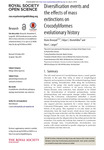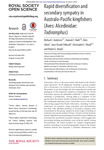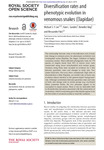Search
Now showing items 1-10 of 12
Back to Tanganyika
(2015)
The species flocks of cichlid fishes in the East African Great Lakes are the largest vertebrate adaptive radiations in the world and illustrious textbook examples of convergent evolution between independent species ...
Revision of the Late Jurassic teleosaurid genus Machimosaurus
(2014)
Machimosaurus was a large-bodied genus of teleosaurid crocodylomorph, considered to have been durophagous/ chelonivorous, and which frequented coastal marine/estuarine ecosystems during the Late Jurassic. Here, we revise ...
Regional differentiation and extensive hybridization between mitochondrial clades of the Southern Ocean giant sea spider Colossendeis megalonyx
(2015)
Assessing the enormous diversity of Southern Ocean benthic species and their evolutionary histories is a central task in the era of global climate change. Based on mitochondrial markers, it was recently suggested that the ...
Diversification events and the effects of mass extinctions on Crocodyliformes evolutionary history
(2015)
The rich fossil record of Crocodyliformes shows a much greater diversity in the past than today in terms of morphological disparity and occupation of niches. We conducted topology-based analyses seeking diversification ...
Rapid diversification and secondary sympatry in Australo-Pacific kingfishers
(2015)
Todiramphus chlorisis the most widely distributed of the Pacific’s ‘great speciators’. Its 50 subspecies constitute a species complex that is distributed over 16 000km from the Red Sea to Polynesia. We present, to our ...
Diversification rates and phenotypic evolution in venomous snakes
(2016)
The relationship between rates of diversification and of body size change (a common proxy for phenotypic evolution) was investigated across Elapidae, the largest radiation of highly venomous snakes. Time-calibrated ...
A spectacular new species of seadragon
(2015)
The exploration of Earth’s biodiversity is an exciting and ongoing endeavour. Here, we report a new species of seadragon from Western Australia with substantial morphological and genetic differences to the only two other ...
First report of Plesiochelys etalloniandTropidemys langiifrom the Late Jurassic of the UK and the palaeobiogeography of plesiochelyid turtles
(2016)
Plesiochelyidae is a clade of relatively large coastal marine turtles that inhabited the shallow epicontinental seas that covered western Europe during the Late Jurassic. Although the group has been reported from many ...
Unnoticed in the tropics
(2015)
Ricinulei are among the most obscure and cryptic arachnid orders, constituting a micro-diverse group with extreme endemism. The 76 extant species described to date are grouped in three genera:Ricinoides, from tropical ...
The unexpected survival of an ancient lineage of anseriformbirds into the Neogene of Australia
(2016)
Presbyornithids were the dominant birds in Palaeogene lacustrine assemblages, especially in the Northern Hemisphere, but are thought to have disappeared worldwide by the mid-Eocene. Now classified within Anseriformes ...










